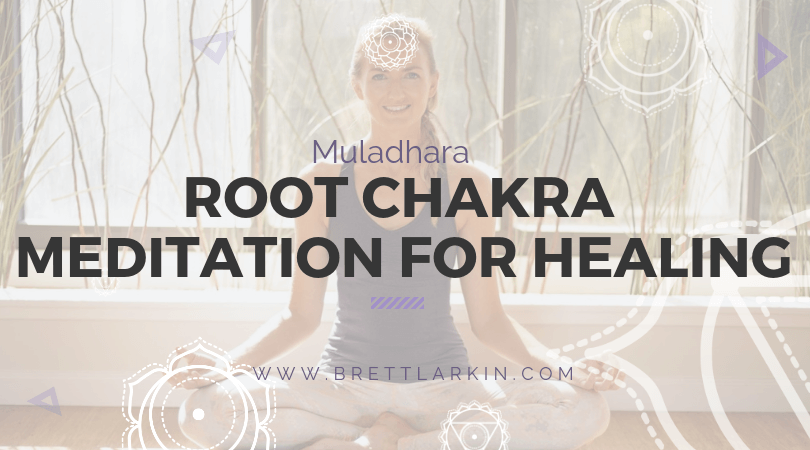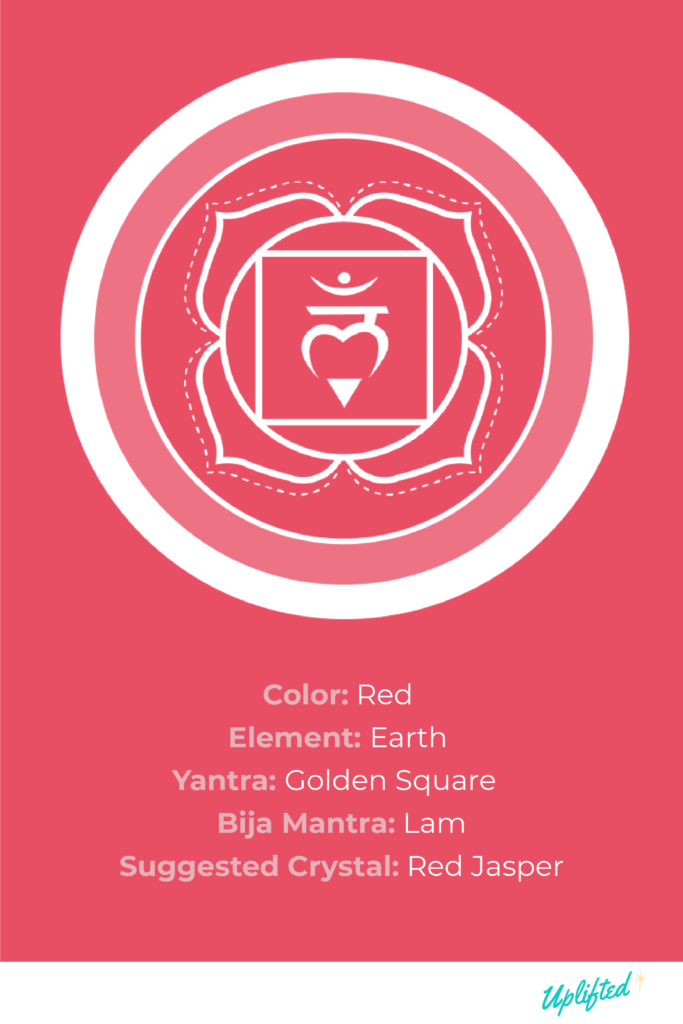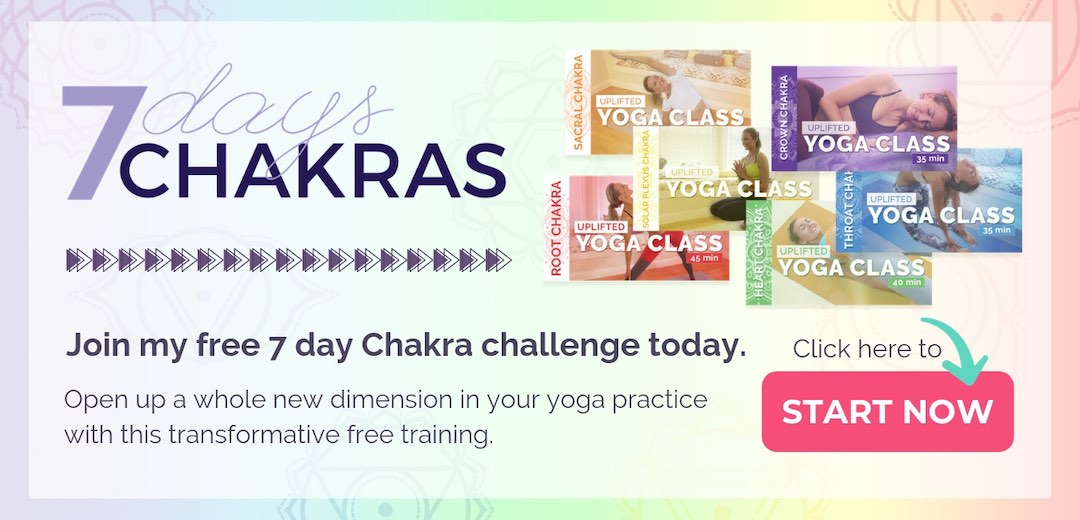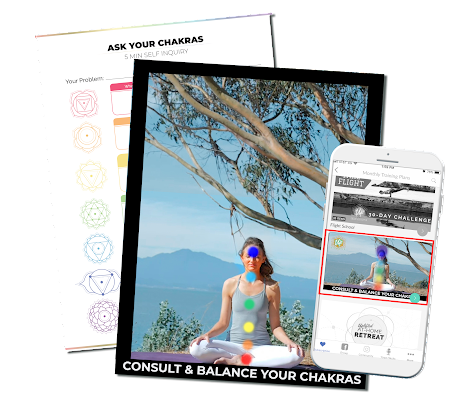If you’ve set foot in a yoga or meditation class lately, chances are you’ve heard some mention of the chakras.
In the West, we frequently see chakra balancing presented as mystical energy centers in the body, that we must “open,” “balance, or “activate” in order to gain spiritual development and awakening.
But where do these ideas come from?
What is a chakra, really?
What can study and understanding of the chakras do for us?
And, perhaps most importantly…
How do you pronounce the word chakra?!
Get answers for all your most burning chakra questions, and learn about the first chakra in the commonly-found Seven Chakra System: the root chakra, or muladhara.
What is a Chakra?
The word chakra refers to a point in the body where powerful channels of energy converge, creating an energy center that is sometimes represented as a lotus flower, or a spinning disk.
In fact, the Sanskrit root of the word chakra comes from the word for “wheel.”
It’s important to note that the word chakra is pronounced CHah-kruh: the first sound of the word sounds like the ch in ‘chocolate factory’, not sh as in ‘shopping mall.’
If you’ve overheard yogis sipping turmeric lattes and talking about healing their “shakras” by wearing a six-pointed star made of clear quartz next to their lapis lazuli chakra bracelet while doing kundalini Hatha yoga, don’t freak out.
The word is commonly mispronounced in the West. It’s also widely misunderstood in western cultures, but more on that later.
Take my chakra quiz to find your dominant chakra:
The Muladhara Chakra Meanings
The word mula in Sanskrit means “root,” while adhara means “support.” In the Seven Chakra System, this is the first energy center in sequential order, and is often considered to reside at the base of the spine near the coccygeal plexus.
Tantric yogic texts link muladhara, or the root chakra, with the natural element of Earth.
Imagine sitting on the earth in a meditation posture. Your legs are crossed, and the base of your spinal cord rests with your pelvis on the floor. As the the Earth supports your physical being, it transmits that instinct through the base of your spine. Any electromagnetic frequency, energy, or sense of grounding are absorbed into the body through the pelvis.
In the Seven Chakra System, each of the subsequent chakras is thought to reside higher up along the spinal column, each connected by the channel of prana, or vital life force energy that flows up and down through the spine, or shushumna.
With muladhara chakra making up the foundation of this energy system, we can understand this chakra as the ground-level support for everything our energy allows us to accomplish in this lifetime.
Along this reasoning, the open root chakra has become associated with the psychology surrounding our basic survival.
On the most primal human level, what do you require in order to thrive? What supports your physical reality? Is it necessities such as food, water, and shelter?
Or, perhaps you feel supported on a grander scale by the Earth itself, whose abundance nourishes all of the life found on this planet.
If you feel strongly connected to your own roots, then muladhara chakra could embody your relationship with family, your basic sense of trust and safety, or the feeling of belonging.
Imbalance in the Root Chakra
As this energy center is thought to deal with primal levels of survival and fear, any thoughts of anxiety, mistrust of others, or concern that your basic needs won’t be met can indicate imbalance or blockages in the root chakra.
These imbalances, or blockages, can manifest in the physical body in any number of ways: from sore guts and indigestion to eating disorders and lower body pain.
Root Chakra Healing
You can balance, heal, or open the muladhara chakra through any practice that serves to ground you and helps you feel the omnipresent support of the Earth.
Traditionally, Tantric yogis would meditate on the color, deity, and sound vibration associated with the Earth element, which corresponds to the root chakra.
You can try this for yourself. The root chakra color is red and the sound vibration, or seed mantra, is Lam (which rhymes with thumb, not pram). Try incorporating the healing image of a beautiful lotus with red petals resting in the bowl of your pelvis.
To calm your mind using the muladhara mantra, sit with a tall spine and eyes closed until you feel a sense of equanimity. Take a deep breath and as you exhale, intone the mantra Lam until you feel energy flow through your body. Pause to notice any effect the vibration has had on your vital energy or mental state.
You can tap into a balanced first chakra by finding stability in yoga postures such as tadasana mountain pose, balasana child’s pose, or your own variation of a padmasana meditation seat.
Root Chakra Meditation
To try this grounding meditation practice, start by getting outside. Take your shoes and socks off.
Find a spot where you can stand on the bare earth, whether it’s a National Park or a strip of grass with a stop sign on it. It doesn’t matter how big and beautiful the stretch of earth is; you just need enough space to stand.
Now! here’s where I want you to remember that chakra energy isn’t stapled by God to any particular part of your body.
(Can you imagine that? God wielding heavy black Swingline office supplies???)
Get that image out of your head, because you are going to activate your root chakra not through the base of the spine, but through the soles of your feet.
(I mean, come on. God?! With a stapler?!)
When you feel your bare feet connect with the Earth, allow each of your vertebrae to stack and rest straight and tall. Perhaps closing your eyes, consciously soften your shoulders down away from your ears and allow your arms to relax by your sides. With gently bent knees, bring your awareness into the soles of your feet.
You may become aware of a subtle interplay of energy between the Earth and your skin. Notice the weight of your legs and feet pressing down on the ground, and feel that equal and oppositional upward force holding you in place.
Gradually allow your awareness to travel up along your body, feeling each body part stacking atop the part below it, supported by your foundation.
When you reach the point where your spinal cord meets the base of your skull, imagine the crown of your head being lifted high into the sky, and rest in this equilibrium for as long as you like.
Next Steps:
- Explore my Chakras knowledge hub to learn more about the Chakras from the blog.
- Check out my YouTube channel and find some yoga classes that you can try out for yourself!
- Join Uplifted for exclusive chakra content that you can access right from the app. Take a deep dive into your practice with me this year!
YOU MIGHT ALSO LIKE
- Chakra Dance: An Intuitive Way To Move Energy
- Yoga to Connect with Your Heart: 3 Poses for Emotional Balance
- Crystals For Chakras: Unlock Your Energy and Balance
- Third Eye Chakra Blocked Symptoms & Healing Techniques
- Blocked Throat Chakra Symptoms & Healing Techniques
- Heart Chakra Blocked Symptoms & Healing Techniques
- Symptoms Of Blocked Crown Chakra & Healing Techniques
- Chakra Opening Symptoms: Signs You’re Unblocking Your Chakras
- Blocked Sacral Chakra Symptoms & Healing Techniques
- Root Chakra Blockage Symptoms & How To Unblock It
- 7 Chakra Imbalance Symptoms: Energetic, Physical, And Emotional
- Solar Plexus Blocked Symptoms And How To Balance
- Sahasrara: Crown Chakra Meditation For Healing and Balancing [VIDEO]
- Ajna : Third Eye Chakra Meditation For Healing and Balancing [VIDEO]
- Vishuddha : Throat Chakra Meditation For Healing and Balancing [VIDEO]
- Anahata: Heart Chakra Meditation For Healing and Balancing [VIDEO]
- Manipura: Solar Plexus Chakra Meditation For Healing and Balancing [VIDEO]
- Svadisthana: Sacral Chakra Meditation For Healing and Balancing [VIDEO]
- 5 Healing Ways to Balance Your Chakras (Right Now)
- Muladhara: Root Chakra Meditation For Healing and Balancing [VIDEO]












